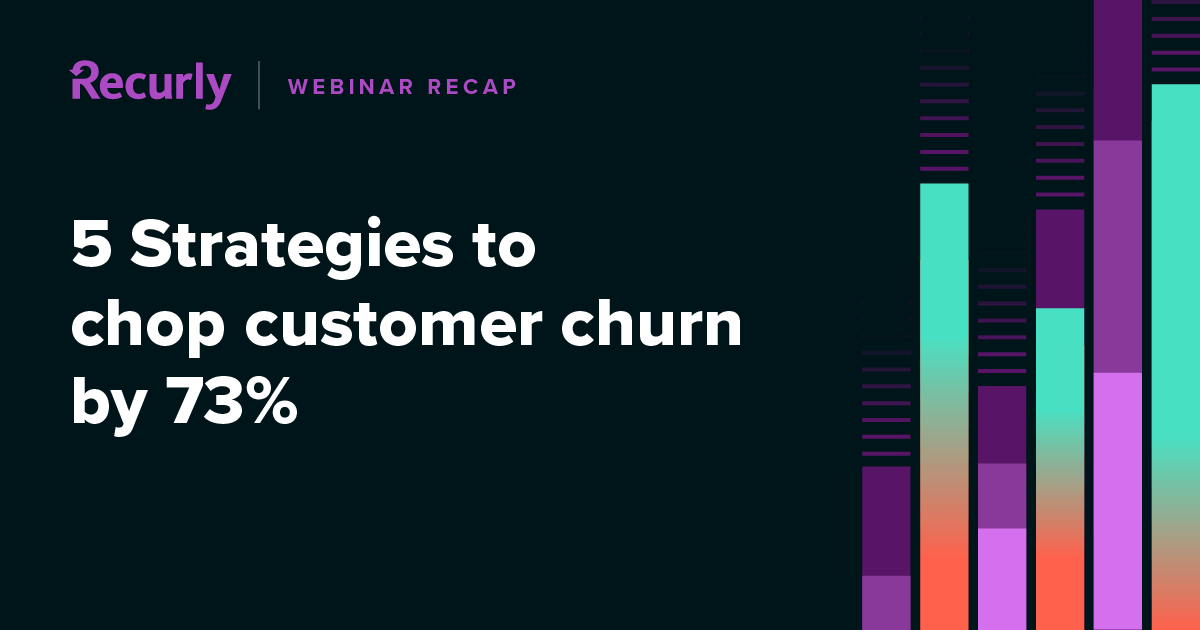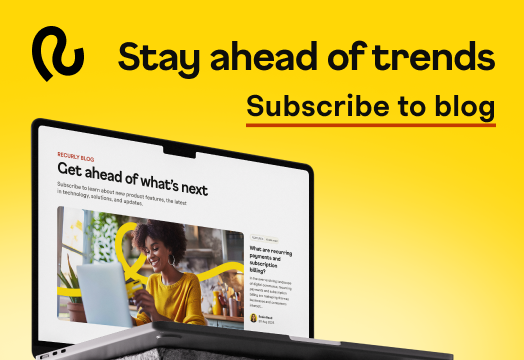Chop churn by 73%: 5 effective churn management strategies

Churn is a reality in subscriptions. Businesses are constantly looking for new ways to identify, manage, and reduce churn.
Last month, Recurly experts Eric Holle, Senior Product Manager, and Jonas Flodh, Chief Product Officer, sat down with David Krauss, Vice President of Product Marketing, to discuss effective churn management strategies in the virtual webinar: 5 strategies to chop customer churn by 73%.
Subscription insights & benchmarks
Benchmarking is crucial–it’s the map to understand where you’re at. Monitoring subscriber data helps you understand business impact, identify performance trends, and make informed business decisions. Key subscription benchmarks include:
Overall churn rate
Churn by industry and subscriber cohort
Churn by average revenue per customer (ARPC)
Involuntary vs. voluntary churn metrics
Use these numbers to identify where the gaps and opportunities are against your peers and create an action plan to address them.
How does your churn rate compare? Discover data by industry, audience, and price point to gauge the health of your business.
Best practices: finding opportunities in data
Turn information into data. Erick Holle shares tips for actioning subscription insights:
Segment by voluntary and involuntary churn
Benchmark against industry data and trends
Identify what’s working and what’s not and assess downstream impact
Understand pains and gaps
Create a roadmap for success and agree on metrics to be tracked
Prioritize the highest opportunities to impact churn
When interpreting your performance results, look back toward your product and plan goals to answer the question: Are your customers getting the best value during the entire lifecycle?
Create a roadmap based on cohort benchmark data for proactive and reactive plans of attack to reduce churn.
Preventing voluntary churn
Voluntary churn happens when a customer is actively looking to cancel their subscription. This year, 31% of U.S. consumers plan to cancel at least one subscription service. How can businesses fight against this stat?
Proactive approach: Make sure your customers know how to get the most value out of your product. Stay on top of your subscriber experience to spot early churn-risk indicators. Based on these zombie segments, target low-engaged customers with the appropriate communications.
Reactive approach: Implement optimized workflows and communications, and offer alternatives during cancellation requests like pausing, discounts, and downgrade options.
Preventing involuntary churn
Involuntary churn results from payment failures. Considering that 13% of recurring transactions are at risk of failing every month, how can subscription businesses address declines?
Leverage an account updater to manage expired card services and date forwarding
Offer payment alternatives and work with backup gateways for payment processing
Design a global and localized payment strategy
Involuntary churn is a black hole no one wants to fall into. Jonas Flodh shares the watch-outs to consider when trying to reduce involuntary churn:
Be cautious of blanket statements on recovery claims
Validate the data you are looking at covers behind-the-scenes strategies
When comparing data, be sure they are apples to apples
Subscription renewals are key to a successful subscription business. Leverage retries and dunning to increase payment success.
Revenue recovery with retry logic and dunning
Retry logic and dunning are the two main pillars of recovered revenue. Retry logic is a machine learning-based algorithm that ensures the highest success rate for subsequent transaction retries after an initial failure. Dunning is the communication piece that complements the retry schedule and encourages subscribers to update their billing information.
Dynamic credit card retry logic
Recurly’s analytical models use data points from millions of historical transactions to generate a retry schedule customized to the attributes of each invoice. Our customers can recover both ‘hard’ and ‘soft’ card declines to improve billing continuity and reduce churn.
Dunning best practices
The goal of dunning is to get customers to take action to update their payment information. Finding the right way to communicate with your customers is essential–the right message, at the right time, at the right channel. Here’s how to excel at dunning:
Design a multi-channel communications strategy that notifies subscribers via email, SMS, or in-app messages
Rely on data to optimize your dunning window communications
Run cohort-based dunning campaigns (by plan, region, terms, monthly vs. quarterly, etc.)
Measure your dunning effectiveness based on invoice recovery rate, revenue recovered, and subscriptions saved.
With a two-approach strategy, fighting churn proactively and reactively, Recurly customers were able to recover more revenue, keep more subscribers, and increase the lifetime value of consumers.
Want to learn more?
Get all the insights and benchmarks you need to build effective churn management strategies in our on-demand webinar 5 strategies to chop customer churn by 73%. Or book a demo with our team to learn how Recurly can help you reduce churn.


